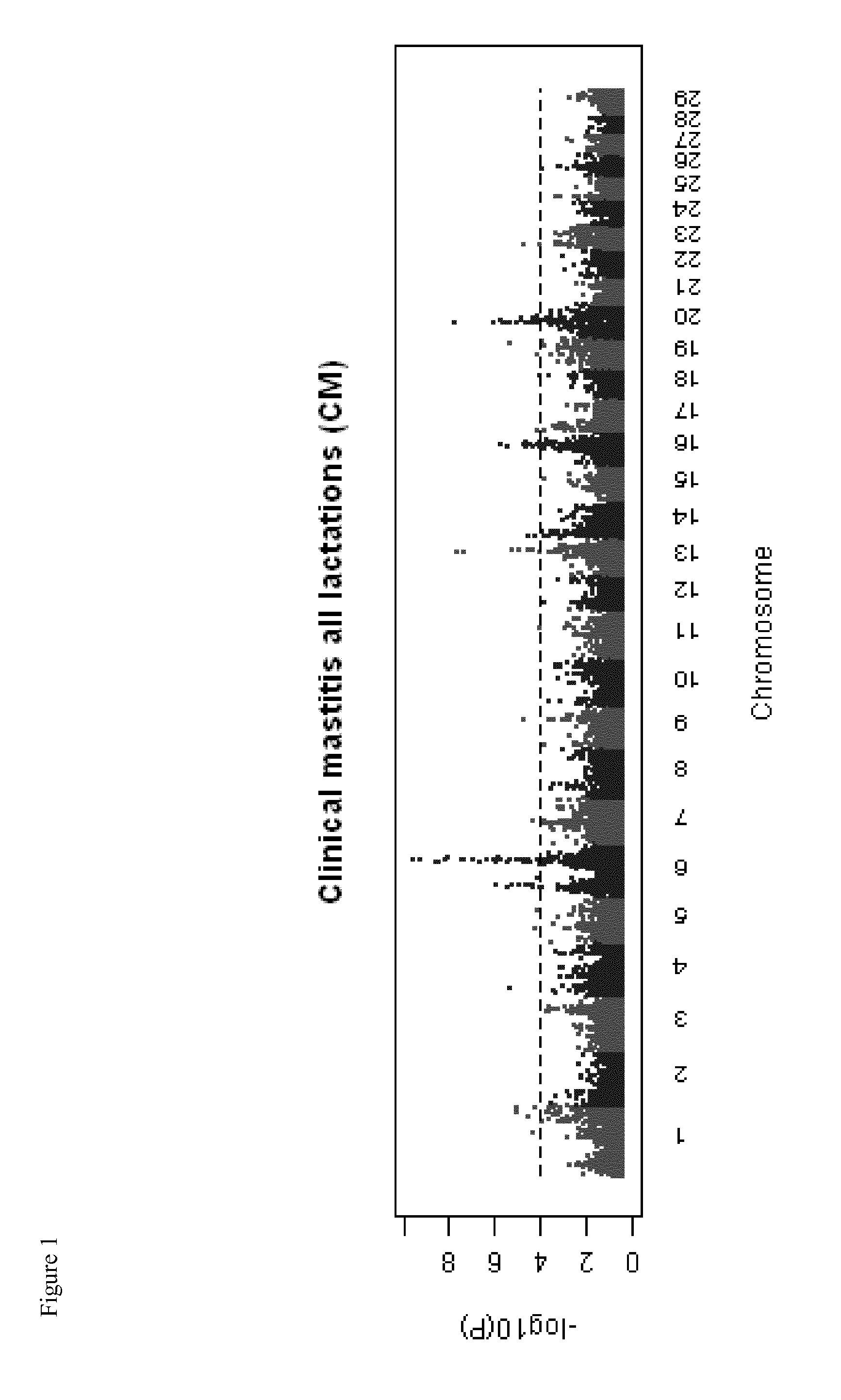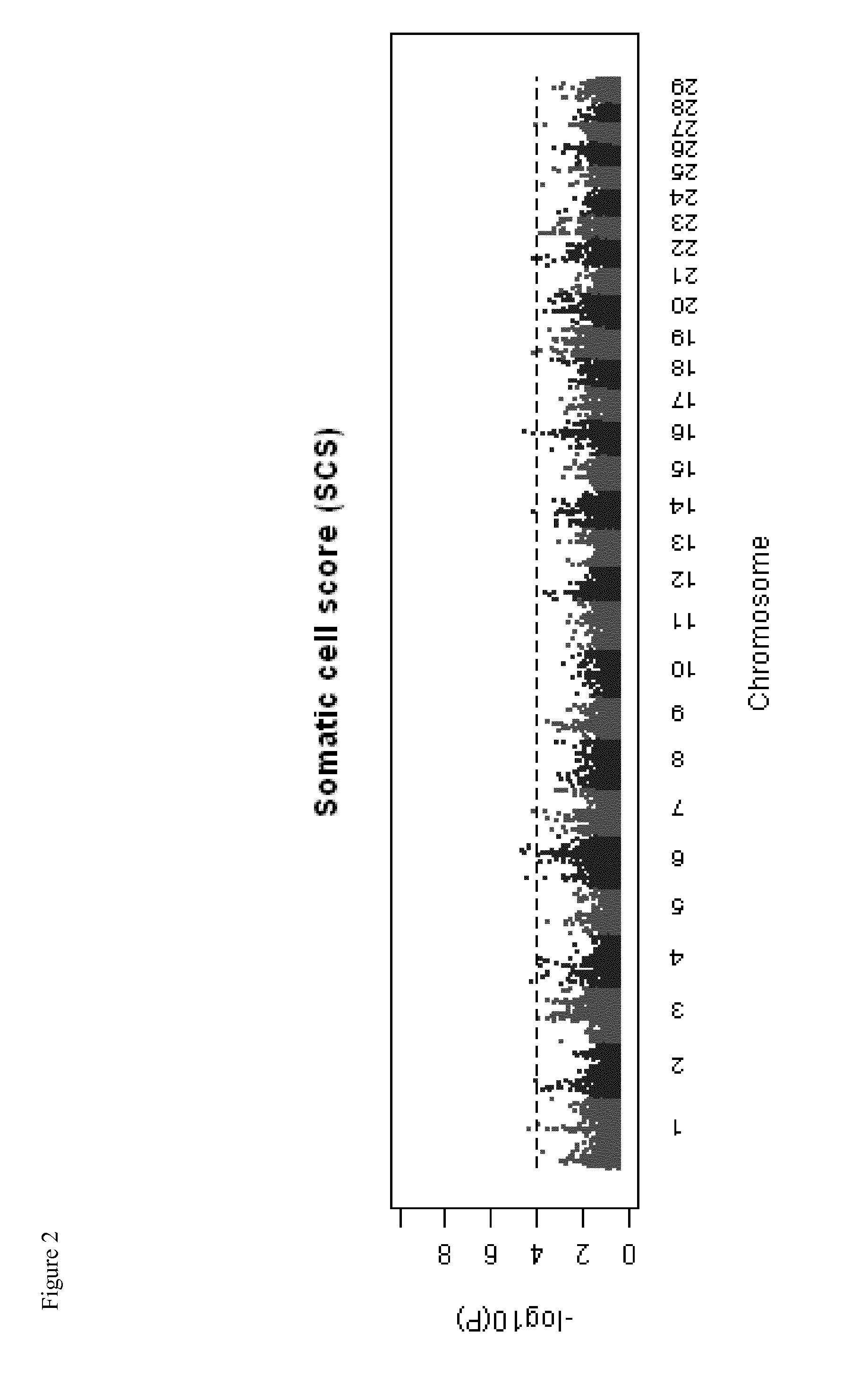Genetic Markers for Mastitis Resistance
- Summary
- Abstract
- Description
- Claims
- Application Information
AI Technical Summary
Benefits of technology
Problems solved by technology
Method used
Image
Examples
example 1
Fine-Mapping of Clinical Mastitis and Somatic Cell Score QTL in Dairy Cattle
Introduction
[0153]Genome-wide linkage analysis was until recently the method of choice for quantitative trait loci (QTL) genome scan in cattle due to availability of large half-sib family structure. Linkage analysis is the method traditionally used to identify genes for phenotypes exhibiting Mendelian inheritance. For complex phenotypes such as quantitative traits, linkage analysis has only had limited success. In linkage analysis there are a few opportunities for recombination to occur within families and pedigree with known ancestry, resulting in relatively low mapping resolution which limits the candidate polymorphism search. In the contrary, association mapping (linkage disequilibrium mapping) has emerged as a powerful tool to resolve complex trait variation down to the sequence level by exploiting historical recombination events at the population level for high resolution mapping. In this approach marke...
example 2
Ultra-Fine-Mapping of Clinical Mastitis and Somatic Cell Score QTL in Dairy Cattle
[0174]Clinical mastitis and somatic cell score QTL in dairy cattle were fine-mapped using high-density SNP Chips comprising 777,962 SNP probes.
[0175]Association mapping identifies specific functional variants (i.e., loci, alleles) linked to phenotypic differences in a trait, to facilitate detection of trait causing DNA sequence polymorphisms and / or selection of genotypes that closely resemble the phenotype. Association mapping has been variously defined (Chakraborty and Weiss 1988; Kruglyak 1999), and has also been referred to as “association genetics,”“association studies,” and “linkage disequilibrium mapping”. Genome-wide association studies (GWAS) provide an important avenue for undertaking an agnostic evaluation of the association between common genetic variants and risk of disease or quantitative traits. Recent advances in our understanding of genetic variation and the technolog...
example 3
Targeted Genome-Wide Association for Causative Mutation Using Whole Genome Sequence Data for a QTL Region on BTA6 (88-96 Mb)
Targeted Region (TR).
[0183]The genomic region from 88-96 Mb on BTA6 was selected for targeted genome-wide association study with SNP variants identified from the whole genome sequence of 90 bulls. This genomic region was selected as it showed the strongest association with clinical mastitis in analyses of the Illumina Bovine SNP50 BeadChip (HD SNP chip). The most significant SNP association with clinical mastitis for HD SNP chip analyses was BovineHD0600024355 located at 88,919,352 Bp on BTA6.
Whole Genome Sequence (WGS).
[0184]The whole genome of ninety bulls from three breeds (˜30 each from Nordic Holstein, Danish Jersey and Nordic Red breed) was sequenced (˜10× coverage) at Beijing Genomic Institute (BGI), China. The whole genome sequences were analyzed and more than 24 million variants were observed. The variants were functionally annotated. The SNP polymorph...
PUM
| Property | Measurement | Unit |
|---|---|---|
| Fraction | aaaaa | aaaaa |
| Electrical resistance | aaaaa | aaaaa |
Abstract
Description
Claims
Application Information
 Login to View More
Login to View More - R&D
- Intellectual Property
- Life Sciences
- Materials
- Tech Scout
- Unparalleled Data Quality
- Higher Quality Content
- 60% Fewer Hallucinations
Browse by: Latest US Patents, China's latest patents, Technical Efficacy Thesaurus, Application Domain, Technology Topic, Popular Technical Reports.
© 2025 PatSnap. All rights reserved.Legal|Privacy policy|Modern Slavery Act Transparency Statement|Sitemap|About US| Contact US: help@patsnap.com



